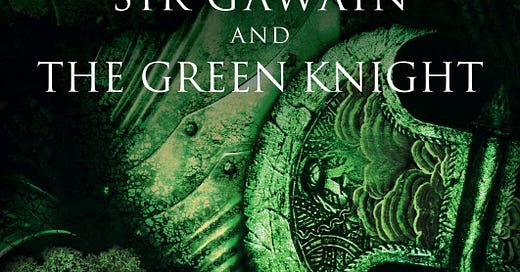Sir Gawain and the Green Knight 9
Study Guide Questions for Stanzas 91-101
If you are looking for the beginning of the study for Sir Gawain and the Green Knight then you can go HERE for a brief introduction. At the bottom of the introduction you will find the links to each section of the study guide as it becomes available. If you would like to see the growing list of book studies available for free on this site you can go HERE. Enjoy!
Virtues/Vices/Great Ideas: (Find them in the Text)
Appearance vs. Reality, Fate, Joy, Justice, Forgiveness, Temptation, Love, Myth
Grammar Questions: (The Information of the Text)
What did Gawain do right as the Green Knight was about to hit him with his ax?
What happened the second time the Green Knight wound up to strike Gawain with his ax?
The third time the Green Knight whirled his ax Gawain's way, what happened?
What was Gawain’s reaction after the knight had taken his swing?
To what did the Green Knight relate each of his three attempts towards striking Gawain?
Whose idea was it for the lady of the castle to attempt to woo Gawain?
What is the Green Knight’s overall evaluation of Gawain’s actions over the last three days?
What did the Green Knight give Gawain to remember this time of testing?
Concerning what did Gawain say “some excuse I think my due”?
Who, in fact, did the lady of the house turn out to be?
According to the story, what was the originally intended purpose of sending the Green Knight to Arthur’s court?
What is Gawain’s own estimation of how well he did during his time of testing?
What did Arthur and the Knights of the Round Table begin to do in honor of Gawain?
Logic Questions: (Interpreting, Comparing/Contrasting, Reasoning)
Why did it please the Green Knight to see Gawain “so stout, so stern there and fearless”?
Why did the Green Knight only “snick” Gawain on the neck rather than chop his head clean off of his neck?
Why did the Green Knight set up the various temptations for Sir Gawain? What was the purpose in all of this?
Why did the Green Knight say “less do I blame you” to Gawain because he “loved [his] own life”?
Why is Gawain so hard on himself about his failure even though the Green Knight declares, “I hold thee purged of that debt, made as pure and as clean as hadst thou done no ill deed since the day that thou wert born”?
What does the poet do in order to provide a bookend to the poem? (Look back to Stanza 1)
Why is the last sentence (at least the last English sentence) of the poem important to the overall story?
The very last line of the book reads: “HONY SOYT QUI MAL PENCE” and is written in a dialect of Old Norman French spoken by the medieval ruling class in England. It translates to something like, "shame on anyone who thinks evil of it". Why do you think the poet ended with this?
Rhetoric Questions: (The Analysis of Ideas in the Text)
Was the Green Knight (a.k.a. Lord Bertilak) a good man or a bad man? Defend your answer with reference to the overall text of the poem.
Do you think Gawain was ever in any real danger? Why or why not? Make your case using the text of the poem and good reasoning.
Is Gawain right to constantly remind himself of his failure? Why or why not? When ought we to remember our past failures? When ought we to let go of our past failures? Explain your answer carefully, making proper distinctions.
Theological Analysis: (Sola Scriptura)
Read Judges 16. How is Samson’s story both similar and different from Gawain’s story? Give several examples each of similarities and differences.
Read 1 John 1:5-10. How does this passage affect your thinking as to Gawain’s ongoing dwelling upon his failure?
Read Romans 8:1-11. How does this passage address human faults and failure and what our attitude should be for those who trust in Christ and are genuine in their repentance?



